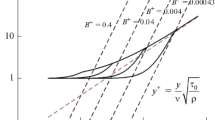Abstract
Turbulent flows in which all mean (time-averaged) values of functions of the fluctuating velocity field are independent of orientation are said to be “statistically isotropic” (Taylor [1]). The macroscopic motion of turbulent flows in which the turbulence is approximately isotropic seem to be well predicted by the so-called k-ε theory, in which the turbulent fluid at the macroscopic scale is assumed to obey the usual Navier-Stokes equations but the viscosity is allowed to vary as a function of the additional “turbulence variables” k and ε. Here, k denotes the “turbulent kinetic energy” per unit mass and ε denotes the “rate of turbulent energy dissipation.” Additional transport equations for k and ε are posed, both of which are similar in form to the usual energy conservation equation. Alternative, but similar, theories of isotropic turbulence have been constructed using the “mixing length” ℓ (Launder and Spalding [2]) or a microscopic “vorticity” scalar ω (Saffman [3]) instead of ε, where these variables are related to k and ε according to ω∝ ε/k and ℓ ∝k 3/2 /ε.
Access this chapter
Tax calculation will be finalised at checkout
Purchases are for personal use only
Preview
Unable to display preview. Download preview PDF.
Similar content being viewed by others
References
G. I. Taylor, Distribution of velocity and temperature between concentric rotating cylinders, Proc. Roy. Soc. Lond. A 151, 494–512 (1935).
B. E. Launder and D. B. Spalding, Mathematical Models of Turbulence, Academic Press, New York 1972.
P. G. Saffman, A model for inhomogeneous turbulent flow, Proc. Roy. Soc. Lond. A 317, 417–433 (1970).
B. E. Launder, G. J. Reece and W. Rodi, Progress in the development of a Reynolds-stress turbulence closure, J. Fluid Mech. 68, 537–566 (1975).
C. G. Speziale, On nonlinear k-ℓ and k-ε models of turbulence, J. Fluid Mech. 178, 459–475 (1987).
C. G. Speziale, Invariance of turbulence closure models, Phys. Fluids 22, 1033–1037 (1979).
C. G. Speziale, Closure relations for the pressure-strain correlation of turbulence, Phys. Fluids 23, 459–463 (1980).
J. L. Ericksen, Conservation laws for liquid crystals, Trans. Soc. Rheol. 5, 23–34 (1961).
F. M. Leslie, Some thermal effects in cholesteric liquid crystals, Proc. Roy. Soc. Lond. A 307, 359–372 (1968).
J. S. Marshall and P. M. Naghdi, A thermodynamic theory of turbulence. Part I. Basic developments, Phil. Trans. Roy. Soc. Lond. A 327, 415–448 (1989a).
J. S. Marshall and P. M. Naghdi, A thermodynamic theory of turbulence. Part II. Determination of constitutive coefficients and illustrative examples, Phil. Trans. Roy. Soc. Lond. A 327, 449–475 (1989b).
J. S. Marshall and P. M. Naghdi, Consequences of the Second Law for a turbulent fluid flow, Continuum Mech. and Thermodynamics 3, 65–77 (1991).
J. M. Burgers, A mathematical model illustrating the theory of turbulence, Adv. Appl. Mech. 1, 171–199 (1948).
A. E. Green and P. M. Naghdi, On thermodynamics and the nature of the Second Law, Proc. Roy. Soc. Lond. A 357, 253–270 (1977).
A. E. Green and P. M. Naghdi, On thermodynamics and the nature of the Second Law for mixtures of interacting continua, Quart. J. Mech. Appl. Math. 31, 265–293 (1978).
A. E. Green and P. M. Naghdi, On thermal effects in the theory of shells, Proc. Roy. Soc. Lond. A 365, 161–190 (1979).
R. G. Deissler, Direction of maximum turbulent vorticity in a shear flow, Phys. Fluids 12, 426–427 (1969).
W. T. Ashurst, A. R. Kerstein, R. M. Kerr and C. H. Gilson, Alignment of vorticity and scalar gradient with strain rate in simulated Navier-Stokes turbulence, Phys. Fluids 30(8), 2342–2353 (1987).
R. M. Kerr, Histograms of helicity and strain in numerical turbulence, Phys. Rev. Lett. 59(7), 783–786 (1987).
Z. S. She, E. Jackson and S. A. Orszag, Statistical aspects of vortex dynamics in turbulence, in New Perspectives in Turbulence (edited by L. Sirovich), Springer-Verlag, New York, 315–328, 1991.
A. E. Green and P. M. Naghdi, Aspects of the Second Law of thermodynamics in the presence of electromagnetic effects, Quart. J. Mech. Appl. Math. 37, 179–193 (1984).
K. Hanjalic and B. E. Launder, A Reynolds stress model of turbulence and its application to thin shear flows, J. Fluid Mech. 52, 609–638 (1972).
W. C. Reynolds, Towards a structure-based turbulence model, in Studies in Turbulence (edited by T. B. Gatski, S. Sarkar and C. G. Speziale), Springer-Verlag, New York 1992.
J. Laufer, Investigation of turbulent flow in a two-dimensional channel, NACA Rept. no. 1053, 1247–1265 (1952).
P. S. Bernard, Limitations of the near-wall k-s turbulence model, AIAA J. 24, 619–622 (1986).
J. C. Neu, The dynamics of stretched vortices, J. Fluid Mech. 143, 253–276 (1984).
B. B. Mandelbrot, Intermittent turbulence in self-similar cascades: Divergence of high moments and dimension of the carrier, J. Fluid Mech. 62 (2), 331–358 (1974).
Author information
Authors and Affiliations
Editor information
Editors and Affiliations
Additional information
Dedicated to Paul M. Naghdi on the occasion of his 70th birthday
Rights and permissions
Copyright information
© 1995 Birkhäuser Verlag Basel/Switzerland
About this chapter
Cite this chapter
Marshall, J.S. (1995). A structural theory of anisotropic turbulence. In: Casey, J., Crochet, M.J. (eds) Theoretical, Experimental, and Numerical Contributions to the Mechanics of Fluids and Solids. Birkhäuser Basel. https://doi.org/10.1007/978-3-0348-9229-2_38
Download citation
DOI: https://doi.org/10.1007/978-3-0348-9229-2_38
Publisher Name: Birkhäuser Basel
Print ISBN: 978-3-0348-9954-3
Online ISBN: 978-3-0348-9229-2
eBook Packages: Springer Book Archive




